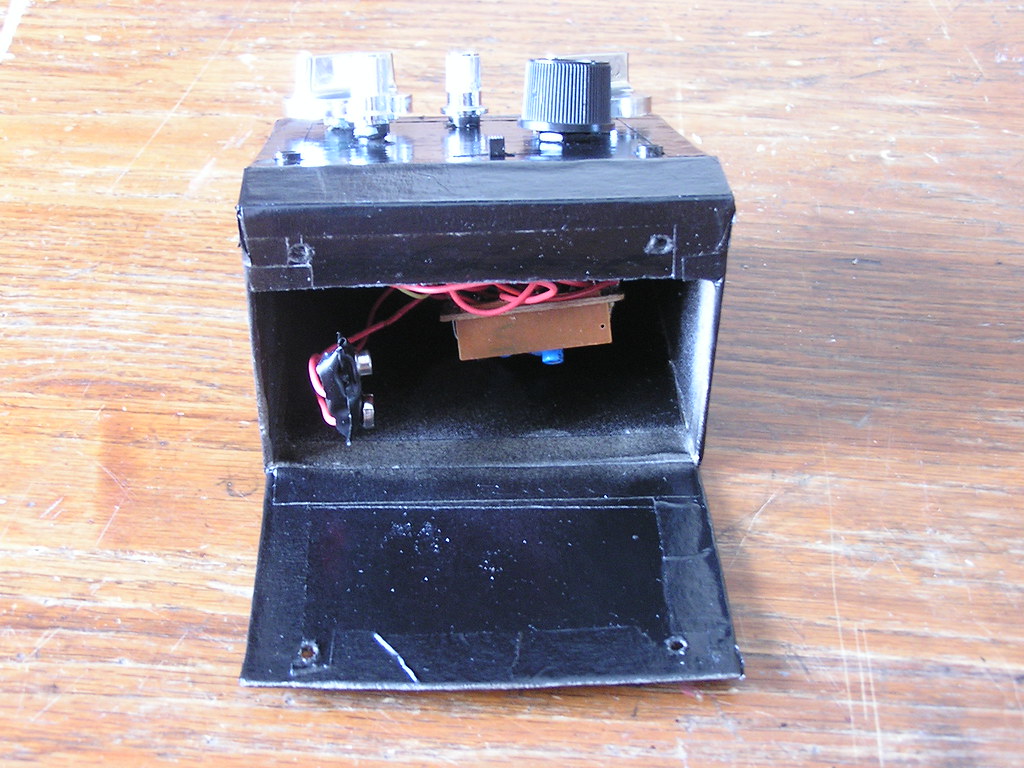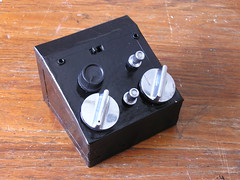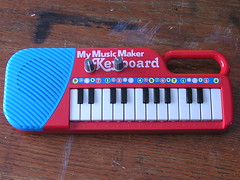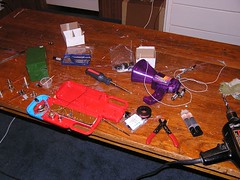Here is the manual for the assembly and operation of my eleventh instrument.
In the picture below, we can see the brackets on the back of the ca-110 to which the smaller keyboard will be attached

Here the ca-110 is preparing it self to recieve the smaller keyboard.

Unfortunately the camera didn't focus the way I hoped it would, but here are the bolts which will be placed inside the brackets, on the back of the ca-110.

When the ca-110 brackets are fitted over the smaller keyboards bolts, there will be no room to place your nut onto the smaller keyboards bolt. For that reason you can see I am holding the ca-110 up while I place, and turn the nut a few times.

Below is the hole which will receive the bolt for the control box. With the ca-110 held upside-down, it will be to the right of the smaller keyboard.

The bracket on the control box:

First connect the control box to the smaller keyboard; it should be obvious how to do so.

Place the bolt through the hole, form the back, so the nut will be tightened against the control box bracket.

Nextly, find the wire which ought to be protruding from the underside of the ca-110, and attach it to the connector closest to the yellow portion of the control box, like so:

Finally attach the voice changer to the only available connector. It will only go in one way.

Next I will explain the control box:

First the color scheme. The green controls belong to the smaller keyboard. The black belong to the voice changer, and the yellow controls the ca-110.
Knobs, such as greens 1a, correspond to a switch, so to use knob 1a you must flip switch 1.
The toggle switches are on/off/(on), which means one side of the switch is momentary. Flip any switch down and it will stay on, flip it up and it will momentarily stay on. This will not matter though, as no bends were attached to the up position of any switch, or no important bends that is.
The yellow controls are momentary push buttons, ad are not meant to be held down, though holding them down may garner results.
Now for what they actually do.
Green:
1:
Activates pitch and distortion bends which are controlled by the knobs 1a, and 1b simultaneously. Unfortunately these bends work best when not amplified, that is to say, when fed through the smaller keyboards speaker. The bends can be random, and two knobs are necessary to fine tune, and control them.
(If you don't want to amplify this bend, but still want to use the voice changer to add distortion, you could mic the smaller keyboard's speaker, and then feed the output of your computer/amp, into the voice changer, and out again)
2:
Distortion
3:
Activates a sustained tone. You can change the tone by pressing a key twice. Different bends from the voice box, and the smaller keyboard can be layered on top to create pretty interesting effects.
4:Distortion
Black:
Black controls correspond to the voice box, as stated earlier. The voice box itself has three settings, alien, monster, and amplify. The three black controls will work with the voice box set to any of its own settings.
1:
I believe this activates a tone, just as green 3 does.
2:
Pitch, to be controlled by knob 2a
3:
Distortion
Yellow:
1,2,3:
Random glitches. Use demo mode or select a beat, and then press a button quickly. They can easily crash the ca-110, but pressing repeatedly can bring it back to life. If not turn the ca-110 off, and then back on. Using these buttons will be trial and error.
Now to explain the wiring:

The outputs, and inputs, are marked on the ca-110, and the smaller keyboard, but not on the voice box. The left side, as pictured above, has two inputs, 1, an 1/8" inch, and 2, a 1/4". The right side has two out puts, 3, 1/8", and 4, 1/4".
To use the keyboards with the voice box (anything that has an output which is, or can be adapted to, 1/8" or 1/4" can be used with the voice box; this includes guitar, and microphone.) simply plug the outputs from both into the inputs of the voice box, and then choose which voice box output you'd like to use, and plug that into your computer, or amp, or whatever.
I have been working on this project for a long time, and because of that I tend to worry about how good it is, but soon Dylan will share with us all how well it works.





















